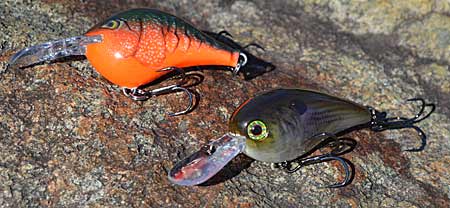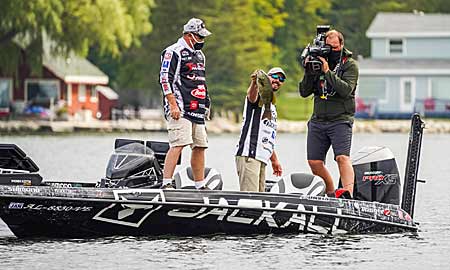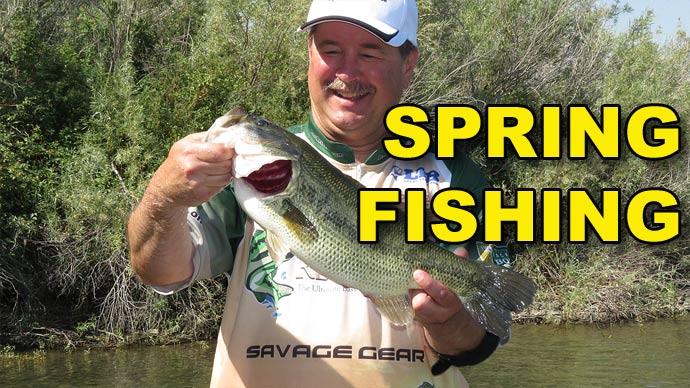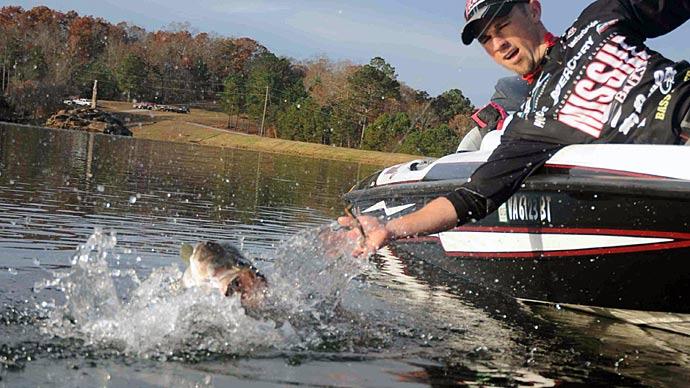
Spring is often compared to an awakening, and rightfully so. Flowers bloom and animals leave their dens, hibernating away the winter. Bass get moving, too. Warming water and more daylight hours tell them it's time to head toward spawning flats from their winter haunts. This prespawn migration can offer some of the best fishing for numbers and size, as long as you make the correct choices to stay with the bass.
Alex Davis knows what it takes to keep up with on-the-move prespawn bass. And more times than not, the Alabama-based angler, who competed on the Major League Fishing Tackle Warehouse Pro Circuit and won a Toyota Series tournament on Lake Guntersville, where he also regularly guides, does that with a crankbait. “I love them because they are so versatile,” he said. “It’s one of my favorite ways to catch them.” These hard baits come in various sizes, shapes, colors, and depths. So, there’s one for nearly any fishing situation you’ll encounter. And there will be plenty along this journey.
Davis looks for a warming weather trend that doesn’t stop to signal the start of prespawn. It continues until the bass go on spawning beds when the water temperature hits 60 degrees. In between, bass hopscotch from one piece of structure and cover to the next as they head toward the water that’s shallow enough for spawning. In lakes and rivers that are stained or muddy, it could be barely enough to cover their backs. And in deep northern lakes filled with crystal-clear water, it could be 10 feet or more.
Each prespawn migration stop can be effectively fished with a crankbait, whether a rock pile in deep water, a channel swing bank, or a bed of aquatic vegetation at the edge of a spawning flat. But you have to choose the best one in the best color and throw it on the best rod, reel, and line for that particular situation. Davis’ advice will help you make those decisions.
Choose a reason
Once bass start their prespawn migration, they don’t stop. It can be work, keeping up with them during a stretch of stable weather. That’s one reason why crankbaits are so effective. They cover plenty of water. “You can fish them fast,” Davis said. “You don’t have to slow down.”
Not only do crankbaits help you cover more spots in less time, but they also cut through spring’s quickly changing weather. Davis said the season is filled with clouds and wind, the effects of weather fronts moving through, ushering in warmer conditions.
Wind makes fishing difficult. It can hinder accurate casts with lightweight lures, for example, and Davis said it could make it nearly impossible to keep in contact with others such as jigs. Crankbaits fight through it. “You can fish them in any condition,” he said. “And if it’s windy, they bite them even better.”
Prespawn bass are hungry bass. They require plenty of calories to sustain their cold-blooded bodies, whose metabolism is quickening in step with the warming water. They also are feeding up on the rigors of the rapidly approaching spawn.
Davis said that hunger makes prespawn bass aggressive. Rarely do they not take his crankbait inside their mouth. Triggering strikes, though, often requires some contact. For example, that can cause a square-bill or mid-depth diving crankbait to ricochet backward or upwards 6 inches or more. “If my crankbait isn’t hitting bottom, I don’t need to try it,” he said. That also goes for bumping into branches of laydowns or popping free of aquatic vegetation. “That’s definitely what’s getting the bites,” he said.
Choose a crankbait
Crankbait design, shape, and action make them mimic two favorite bass meals — baitfish and crawfish. But correctly creating those illusions during the rapidly changing prespawn requires making several choices.

Davis lets water temperature determine his crankbait’s color during the prespawn. Early in the season, when the water is colder than 55 degrees, he chooses crankbaits that sport plenty of red. He switches to baitfish patterns when the water temperature exceeds that, leaning toward more natural-looking ones in clear water and ones with chartreuse when the water is stained or dirty. He lets the bass tell him the exact color that they want. “They can be as picky as wanting a little chartreuse in red, not solid red,” he said.
Water temperature also determines the shape of Davis’ crankbait. He prefers flat-side ones in cold water, where their tight shimmy attracts more bites. Those include Jackall’s Bling 55 or any balsa ones carved in eastern Tennessee. As it warms, he switches to more rounded crankbaits, whose wobbles are slower and broader, such as Jackall’s MC60 or Rapala’s DT6. “Those are two of the best baits for prespawn,” he said.
Don’t assume these colors and styles of crankbaits only work in their respective water temperatures. Davis said flat-sided ones would work in warmer water, just not as well as rounded ones. That’s the case with many tackle adjustments. Each may lead to a bite or more by the end of the day, so the more you make, the more bass you’ll catch. In fishing, silver bullets are collective efforts.
The type of cover Davis is fishing also determines which crankbait he will fish. He'll use a square-bill crankbait in shallow water if it’s hard cover, such as rocks, stumps, or laydowns. They deflect off the cover, compared to a rounded bill, which rolls through it, creating an erratic action that draws reaction strikes. And if he’s faced with submerged aquatic vegetation, like what fills Guntersville, he turns to a lipless crankbait.
Lipless crankbaits play a precise role in Davis’ fishing. He only fishes one — usually a Jackall TN70, which measures almost 3 inches long and weighs 5/8 ounce — around aquatic vegetation, and he retrieves it one way. He lets it settle into the grass to the point where it hangs up, then pulls it free with a quick snap of his rod’s tip. That fleeing action draws vicious strikes from prespawn bass, who often school in aquatic vegetation. “I think they’ll eat anything when they do that,” he said.
Choose an outfit
Picking the best crankbait and retrieve for where and when you’re fishing during the prespawn will put more and bigger bass in your boat. But you’ll do better using the right rod, reel, and line.
Davis is a big believer in fishing crankbaits with rods that bend along their entire length. That slow action serves three purposes.

First, it lets bass inhale your crankbait, leading to more hookups. Fast-action rods, which only bend at the tip, react quickly to your hook set, often pulling crankbaits away from light-biting bass. “You’ll jerk it away as soon as you feel it,” Davis said. When you set the hook with a slow-action rod, it takes time to load the rod before you can move the line and hooks. “It slows your reaction time,” he said. That delay allows those bass to get your crankbait in their mouth.
Secondly, slow-action rods make easy work of casting light-weight lures, such as the flat-sided balsa models that Davis prefers in the coldest waters of prespawn. They take less effort to load, allowing you to use all of their casting power.
And lastly, slow-action rods help ensure bass stay pegged on treble hooks. Having six hook points on your crankbaits is suitable for grabbing bass that swipe at your crankbait. But it can be bad, too. Your force is spread across as many as are in the bass, reducing the pressure on each. The opposite is true when you use lures with a single hook, such as vibrating jigs. Any slack line means those hooks can be easily thrown. When fighting bass quickly change directions or jump, slow-action rods work as a shock absorber, moving with them and keeping steady constant pressure on hooks.
Davis finds all those slow-action benefits in Shimano’s Zodias glass rod. He prefers the 7-foot, 2-inch model for fishing lipless crankbaits. Its medium-heavy power offers enough backbone to make crankbaits pop free of aquatic vegetation and set the hook at the end of long casts. He switches to a medium power 7-foot model for the rest of his prespawn cranking. Its slightly shorter length offers accurate casting and is a better match for lightweight crankbaits with less power.
Each of Davis’ cranking rods is matched with a Shimano Metanium reel. He said it casts light-weight lures well, and its middle-of-the-road gear ratio of 6.3:1 helps keep him from fishing too fast in colder water temperatures.
Davis loads his lipless-crankbait reel with 15-pound test P-Line Tactical fluorocarbon line; its strength and abrasion resistance stand up to the most demanding aquatic vegetation. And with a little stretch, his lipless crankbaits dart from the grass with only a twitch of his rod. He relies on the same line, dropping down to 10-pound test, for his diving crankbaits. “Its small diameter helps your bait dive deeper, too,” he said.
BassResource may receive a portion of revenues if you make a purchase using a link above.




